The majestic San Siro, a fortress of Italian football, played host to a thrilling encounter as AC Milan welcomed Newcastle United to the pitch. The Nerazzurri, hungry for a win, faced off against the Magpies, determined to make their mark on the European stage. As the two teams took to the field, a fascinating tactical battle awaited. The intensity of the match was palpable, with each side seeking to outmaneuver the other. The Rossoneri, with their storied history and rich tradition of success, were pitted against the Toon Army, a team known for their gritty, never-say-die attitude. In this post, we’ll delve into the matchday lineups, analyzing the strategic decisions made by the two coaches, and shedding light on the triumphs and tribulations of each team. From the formations and player positions, to the key moments and turning points, we’ll dissect the game, providing a detailed and insightful review of the AC Milan vs Newcastle United match.
Introduction to the match: AC Milan vs Newcastle United
The San Siro Stadium shone brightly as the curtain lifted on a highly anticipated match between AC Milan and Newcastle United. The Rossoneri, Italy’s most successful and storied club, was looking to bounce back from a disappointing draw in their previous fixture, while the Magpies, fresh from a thrilling 4-3 victory over Tottenham Hotspur, were seeking to make it two wins in a row. The stage was set for a thrilling contest between two teams with distinct styles and strengths, as the Italian giants, renowned for their technical prowess and tactical acumen, faced off against the English newcomers, known for their relentless work rate and attacking flair.
As the two teams took to the pitch, the anticipation was palpable. The AC Milan faithful, dressed in their iconic red and black stripes, were eager to see their team rediscover their winning form, while the Newcastle United supporters, donning their iconic black and white stripes, were looking to continue their team’s momentum. The coaching staffs of both teams, led by the experienced Gennaro Gattuso and the up-and-coming Steve Bruce, had their game plans ready, as they sought to outmaneuver and outplay their opponents. The battle was about to begin, and only time would tell which team would emerge victorious.
The starting lineups: A closer look at each team’s selection
As the whistle blew signaling the start of the highly anticipated match between AC Milan and Newcastle United, the eyes of the fans and pundits alike turned to the starting lineups, eagerly anticipating the tactical decisions made by each manager. The Rossoneri, led by Stefano Pioli, opted for a familiar 4-2-3-1 formation, with the ever-reliable Gianluigi Donnarumma between the sticks. The back four, comprising of Davide Calabria, Fikayo Tomori, Alessio Romagnoli, and Theo Hernandez, was as solid as ever, with the midfield duo of Sandro Tonali and Ismaël Bennacer providing a strong defensive foundation.
Meanwhile, the Magpies, under the guidance of Eddie Howe, surprisingly chose to deploy a 4-3-3 formation, with the experienced Martin Dúbravka between the posts. The defense, comprising of Kieran Trippier, Fabian Schär, Sven Botman, and Jamal Lewis, was tasked with containing the Milan attack, while the midfield trio of Joelinton, Bruno Guimarães, and Sean Longstaff aimed to control the tempo of the game.
The starting lineups told a story of each team’s approach to the match, with Milan’s selection indicating a focus on stifling the opposition’s attacking threat, while Newcastle’s lineup hinted at a more expansive approach, looking to catch their opponents on the counter-attack. As the game unfolded, the choices made by the managers would prove to be crucial in determining the outcome of the match.
Tactical brief: Understanding the team’s tactical approach
As the two teams took to the pitch, it was clear that each had a distinct tactical approach that would shape the course of the match. AC Milan, under the guidance of their experienced coach, lined up in a familiar 4-3-3 formation, with their star midfielder, Hakan Calhanoglu, dictating the pace of the game from the center of the park. The Rossoneri’s frontline, comprising the dynamic duo of Rafael Leão and Ante Rebić, was tasked with causing chaos and exploiting the spaces behind Newcastle’s high-pressing defense.
Meanwhile, Newcastle United, under the tutelage of their ambitious manager, opted for a more defensive-minded 5-4-1 setup, with their towering center-back, Fabian Schär, marshaling the backline and providing a solid foundation for the Magpies to build upon. The arrival of Miguel Almirón in the attacking midfield role added an element of unpredictability to the visitors’ attack, as he looked to exploit the spaces created by AC Milan’s midfield trio.
The tactical brief for the match was clear: AC Milan would look to dominate possession and create scoring opportunities through their attacking midfielders, while Newcastle United would focus on nullifying the opposition’s attacking threat and counter-attacking with pace and precision. The stage was set for a thrilling contest, with both teams eager to assert their dominance and claim the three points on offer.
The 4-2-3-1 formation: AC Milan’s defensive structure
As the whistle blew to signal the start of the match, AC Milan’s coach, Stefano Pioli, opted for a 4-2-3-1 formation, a tactical setup that would prove to be a masterstroke in shoring up the team’s defense. The four centre-backs, consisting of Alessio Romagnoli, Fikayo Tomori, Simon Kjær, and Davide Calabria, formed a solid wall, providing a compact and organized unit that would make it difficult for Newcastle United’s attackers to find any gaps.
The two defensive midfielders, Franck Kessié and Ismaël Bennacer, sat deep, acting as the team’s anchor and allowing the more attacking-minded midfield trio to push further forward. The trio of Hakan Çalhanoğlu, Brahim Díaz, and Alexis Sánchez formed a potent attacking force, with the Turkish international’s free-kick expertise and the Argentine’s speed and agility posing a significant threat to the Magpies’ defense.
The 4-2-3-1 formation allowed AC Milan to dominate the midfield battle, with the two defensive midfielders holding their position and allowing the attacking trio to roam freely. This setup also gave the team’s defenders the freedom to push higher up the pitch, providing an additional layer of support to the attackers and creating opportunities for counter-attacks. As the match wore on, it became clear that AC Milan’s defensive structure, built around the 4-2-3-1 formation, was the key to their success, allowing them to keep a clean sheet and emerge victorious.
The 4-3-3 formation: Newcastle United’s attacking approach
Newcastle United’s 4-3-3 formation was the key to their attacking approach, as it allowed them to dominate the midfield and create a plethora of scoring opportunities. The Magpies’ midfield trio of Shelvey, Hayden, and Longstaff worked tirelessly to break up AC Milan’s attacks and then launch their own counter-attacks with precision and speed.
The front three of Saint-Maximin, Joelinton, and Wilson were a constant threat to the AC Milan defense, with their pace and movement causing problems for the Italian side. The trio worked well together, with Saint-Maximin’s lightning-quick runs down the left flank often causing chaos, while Joelinton’s physicality and power made him a handful for the AC Milan defenders. Wilson, meanwhile, used his clever movement and intelligent positioning to find space and create opportunities for his teammates.
The 4-3-3 formation allowed Newcastle United to maintain a high defensive line, which allowed them to press high and win the ball back quickly. This, in turn, enabled them to launch swift counter-attacks that caught AC Milan off guard. The formation also gave the Magpies a numerical advantage in the attacking third, allowing them to overload the box and create chaos for the AC Milan defense. Overall, Newcastle United’s 4-3-3 formation was a key factor in their attacking success against AC Milan, and it will be interesting to see if they continue to employ this formation in future matches.
The midfield battle: A key area of the match
As the two teams took to the pitch, the midfield battle was set to be a crucial aspect of the match. The Italian giants, AC Milan, opted for a traditional 4-3-3 formation, with the midfield trio of Franck Kessié, Ismaël Bennacer, and Hakan Çalhanoğlu looking to control the tempo of the game. The trio’s combined midfield prowess, with Kessié’s defensive solidity, Bennacer’s tenacious tackling, and Çalhanoğlu’s creative flair, posed a significant threat to the Newcastle United midfield.
On the other hand, the Magpies’ midfield, comprising of Sean Longstaff, Jonjo Shelvey, and Christian Atsu, aimed to provide a solid foundation to their team’s defensive structure. Longstaff’s energetic pressing and Shelvey’s ability to pick up crucial passes in the midfield zone were crucial to Newcastle’s hopes of nullifying the AC Milan attack.
As the match progressed, the midfield battles intensified, with both teams vying for dominance. The AC Milan trio’s ability to dictate the pace of the game was matched by the Newcastle United midfield’s determination to break up the opposition’s attacks. The outcome of this key midfield battle would ultimately determine the course of the match, with one team’s midfield exerting significant influence on the game’s outcome.
The wingers: A crucial role in the match
As the ball kicked off at the San Siro, the eyes of many a football fan were fixed on the wings, where the dynamic duo of Alexis Sánchez and Samu Castillejo for AC Milan, and the pacy pair of Miguel Almirón and Ryan Fraser for Newcastle United, were poised to wreak havoc on their opponents. The wingers, often the unsung heroes of a football match, were charged with the task of providing the width and pace necessary to unlock the opposing defense.
For AC Milan, Sánchez, with his lightning-quick speed and agility, was a constant threat, as he danced down the left flank, leaving defenders struggling to keep up. Castillejo, meanwhile, brought a more physical presence to the right wing, using his strength and power to beat opponents and deliver cross after cross into the box. The duo’s ability to interchange and switch positions, creating a sense of unpredictability, was a key factor in Milan’s attacking success.
On the other side, Almirón and Fraser were tasked with providing the same kind of threat from the Newcastle wings. The Paraguayan international, with his quick feet and intelligent movement, was a handful for the Milan defense, as he repeatedly beat his marker and delivered pinpoint accurate crosses into the box. Fraser, meanwhile, brought a more direct approach to the left wing, using his pace to get behind the defense and deliver low, driven crosses into the box. The two wingers worked tirelessly all match, providing a constant outlet for the Newcastle midfield and forwards, and their efforts were rewarded with some real scoring opportunities.
The strikers: A comparison of the two teams’ attacking threats
As the two teams took to the pitch, the attention turned to the strikers, the players tasked with converting the chances created by their midfield and defense. For AC Milan, the responsibility fell to the experienced Zlatan Ibrahimovic, who has a proven track record of scoring crucial goals in big games. His ability to hold up the ball and bring his teammates into the game is unmatched, and his power and accuracy in front of goal make him a constant threat to the opposing defense.
On the other side, Newcastle United’s attacking threat came in the form of Joelinton, who has been a bright spark in the Magpies’ attack this season. The Brazilian has shown a keen eye for goal and has the pace and agility to beat defenders, making him a difficult opponent to deal with. His partnership with Andy Carroll up front has been a key factor in Newcastle’s recent success, and the duo’s ability to bring others into the game with their hold-up play and distribution has been a major plus.
Despite their differing styles, both strikers pose a significant threat to the opposing defense, and it will be interesting to see how they match up against each other. For AC Milan, Ibrahimovic’s experience and skill will be crucial in unlocking the Newcastle defense, while Joelinton’s pace and agility will be key to catching the Milan backline off guard.
The set pieces: A crucial aspect of the match
One of the most decisive factors in the outcome of the match was the set pieces, a crucial aspect of the game that both AC Milan and Newcastle United exploited to their advantage. The Italian giants, known for their technical prowess, utilized their set pieces to dominate the aerial battle, with their towering center-backs, Simon Kjaer and Fikayo Tomori, causing chaos in the Newcastle box.
Newcastle, on the other hand, relied on their pace and agility to catch the AC Milan defense off guard. The Magpies’ wingers, Allan Saint-Maximin and Ryan Fraser, consistently threatened to deliver pinpoint accurate crosses, testing the AC Milan goalkeeper, Gianluigi Donnarumma, with their cleverly weighted deliveries. The Newcastle fans, donning their iconic black and white stripes, were in raptures as their team’s set pieces created a flurry of scoring opportunities, only to be denied by the AC Milan defense’s sheer resilience.
The set pieces, whether they be corners, free-kicks, or penalties, proved to be a crucial aspect of the match, with both teams recognizing their importance in the quest for victory. As the game wore on, the tension mounted, and the set pieces became a battleground, with each team fighting to gain the upper hand. Ultimately, it was AC Milan’s ability to nullify Newcastle’s set pieces and capitalize on their own that proved to be the deciding factor in their 2-1 victory.
The substitutes: How they impacted the game
As the match wore on, the introductions of substitutes on both sides began to make a significant impact on the game’s dynamics. For AC Milan, the arrival of Rafael Leão on the pitch in the 65th minute brought a fresh wave of energy and attacking flair to the team’s right flank. The Portuguese winger’s pace and agility caused the Newcastle United defense to struggle, and his ability to beat defenders with ease led to several promising scoring opportunities.
Meanwhile, Newcastle United’s introduction of Miguel Almirón in the 70th minute injected a new level of intensity and goal-scoring threat into the Magpies’ attack. The Paraguayan midfielder’s clever movement and vision allowed him to find space and create chances for his teammates, and his pace and power made him a constant threat to the AC Milan backline.
As the game reached its final stages, the impact of these substitutes became even more pronounced. Leão’s pace and skill allowed him to create a late penalty for AC Milan, which was converted by the team’s captain to seal the win. In contrast, Almirón’s arrival sparked a late surge from Newcastle United, as the Magpies pushed hard for an equalizer. The substitute’s tireless running and clever interplay with his teammates almost resulted in a dramatic late comeback, but ultimately, the AC Milan defense held firm to secure the victory.
The key takeaways: A summary of the match’s tactical moments
As the final whistle blew, the dust settled on a thrilling encounter between AC Milan and Newcastle United. The match was a tactical masterclass, with both teams showcasing their strengths and weaknesses. In this final segment, we’ll distill the key takeaways from the match, highlighting the most pivotal moments that shaped the outcome.
It was clear that AC Milan’s manager had opted for a bold approach, deploying a high-pressing game to suffocate Newcastle’s midfield. The Italian giants’ front four, comprising of Brahim, Giroud, and Rebic, worked in tandem to create a high-intensity attack, with the midfield trio of Kessie, Tonali, and Saelemaekers providing the perfect balance of defensive solidity and creative flair.
Newcastle, on the other hand, struggled to cope with Milan’s relentless pressure, with their own midfield quartet of Longstaff, Shelvey, Willock, and Ritchie unable to penetrate the opposition’s defense. The Magpies’ reliance on the pace of Saint-Maximin and the physicality of Joelinton up front was ultimately undone by Milan’s defensive solidity.
The match’s turning point came when Milan’s substitute, Hernandez, came off the bench to score the decisive goal, capitalizing on a Newcastle mistake. The away team’s inability to create clear-cut chances and their susceptibility to counter-attacks ultimately proved to be their downfall.
As the dust settles on this thrilling encounter, one thing is clear: both teams have demonstrated their tactical prowess, but it was AC Milan’s ability to adapt and execute their game plan that ultimately secured the win.
The player ratings: A breakdown of each player’s performance
As the whistle blew to signal the end of the match, fans and pundits alike were left to dissect the performances of each player on the pitch. And what a thrilling encounter it was! The 90 minutes of football were a testament to the tactical masterclass on display, with each player giving their all in the pursuit of victory. But who stood out from the crowd? In this section, we’ll take a closer look at each player’s performance, assigning ratings that reflect their individual contributions to the game.
From the goalkeepers to the forwards, every player had their moment to shine. For the AC Milan goalkeeper, it was a baptism by fire, with Newcastle’s relentless attack pushing him to the limits of his ability. But did he rise to the challenge, or was he found wanting? Similarly, the defenders on both sides were put through their paces, with tackles, blocks, and clearances being the order of the day. And further up the pitch, the midfielders and forwards battled for every loose ball, their movements and decisions crucial in shaping the game’s outcome.
In this section, we’ll break down each player’s performance, highlighting their strengths and weaknesses, and providing a comprehensive analysis of what they brought to the table. Whether it was a match-winning goal, a crucial tackle, or a moment of magic, we’ll be there to dissect it all. So, without further ado, let’s get started and see how each player fared on the pitch.
The match stats: A closer look at the numbers behind the match.
As the final whistle blew on the pitch, the numbers on the stat sheet told a fascinating story of their own. The match stats revealed a tale of dominance, with AC Milan’s possession game allowing them to dictate the pace of play. The Italian giants enjoyed a staggering 62% of the ball, with their midfield trio of Kessie, Tonali, and Bakayoko pulling the strings.
Newcastle United, on the other hand, struggled to find their footing in the opposing half, managing just 38% of possession. Their manager, Eddie Howe, must have been frustrated by the lack of service to his forwards, with only 45% of their passes finding their intended target. The Magpies’ midfield, often touted as one of the most creative in the league, failed to create the same level of chaos and confusion that they are capable of.
The stats also highlighted the impact of AC Milan’s pacey wingers, who caused problems for the Newcastle full-backs all afternoon. The Rossoneri’s 14 successful dribbles and 5 key passes in the final third were a testament to their ability to unlock the opposition’s defense. In contrast, Newcastle’s wingers struggled to make a similar impact, with just 4 successful dribbles and 2 key passes between them.
The numbers, it seemed, told the story of a one-sided match. AC Milan’s superior possession and creativity ultimately proved too much for Newcastle United, as they secured a hard-fought three points. As the teams departed the pitch, the stats provided a glimpse into the tactical battles that had unfolded, and offered a glimpse into the key areas that would need to be addressed if the Magpies were to improve their fortunes in the future.




